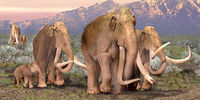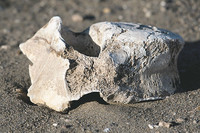Cloudy, 51° F
Federal law enforcement agents and officials rushed to secure the site west of Cody on Tuesday afternoon as word spread quickly about the discovery. The spot is located on Bureau of Reclamation land and the Bureau of Land Management is assisting …
This item is available in full to subscribers.
The Powell Tribune has expanded its online content. To continue reading, you will need to either log in to your subscriber account, or purchase a subscription.
If you are a current print subscriber, you can set up a free web account by clicking here.
If you already have a web account, but need to reset it, you can do so by clicking here.
If you would like to purchase a subscription click here.
Please log in to continue |
|



Skeletal remains found at the Buffalo Bill Reservoir this week appear to belong to an ancient mammoth.
Federal law enforcement agents and officials rushed to secure the site west of Cody on Tuesday afternoon as word spread quickly about the discovery. The spot is located on Bureau of Reclamation land and the Bureau of Land Management is assisting with security.
“We don’t have a huge amount of mammoth finds in Wyoming; it’s a very important discovery,” said University of Wyoming paleobiology professor Mark Clementz, in the department of geology and geophysics.
Cody area resident Todd Legler found the mammoth remains while hiking in the area.
UW archaeology and anthropology professor Marcel Kornfeld said university scientists are in talks with the Bureau of Reclamation on how to save the exposed portion of the skeleton.
“There is no doubt in my mind that it’s a mammoth,” Kornfeld said Wednesday. “It will be important to determine what is there and what is below the surface as soon as possible.”
Kornfeld said photos of the discovery show the visible bones to be in poor condition, eroding away after being exposed to the elements. Officials are attempting to figure out logistics quickly because the area will soon be submerged with snow melt.
Clementz said there are ways to speed up the process of excavating the mammoth, but it’s up to the Bureau of Reclamation as to how they can proceed. Wyoming state archaeologist Greg Pierce has already been contacted by the bureau.
“It’s eroding away pretty fast. A large number of volunteers and manpower could do it faster,” Clementz said.
While genetic testing has yet to be performed, the exposed partially articulated vertebral column and dorsal spines as well as at least one tooth, are believed to be from a Columbian mammoth. But officials on the scene have not ruled out the possibility of more than one mammoth’s remains being present at the site. The species went extinct at the end of the ice age.
Several loose bones and shards cover a distance of at least 30 yards, but it’s too early in the discovery to know the extent of the movement of the bones or if more mammoth remains exist in the area.
The exposed portion of the vertebral column — possibly a section close to the prehistoric mammal’s neck, according to Kornfeld — is only a few feet long. Detached bones andfragments are spread across the immediate area, moved by water after being unearthed.
Law enforcement is investigating whether any remains have been taken from the site, said Mahonri Williams of the Bureau of Reclamation’s Wyoming area office. Officials have been careful to control any foot traffic until all available evidence is collected or documented before the site is submerged.
Fearing the site may be disturbed by sightseers or souvenir collectors, officials asked the exact location not be disclosed.
If no tools or evidence of ancient human interaction with the mammoth are found, the remains would most likely be turned over to paleontologists for further study. If there is evidence that the mammoth was killed and butchered by humans, the importance of the find will grow: Only 15 to 16 mammoth kill sites exist in North America. But considering the location, making that determination could be difficult.
“You could dig for years before finding artifacts like stone tools,” Kornfeld said.
The bones on the surface will need to be salvaged prior to the water rising, said Todd Surovell, professor and department head of archaeology at UW. Surovell is currently excavating the La Prele mammoth site, near Douglas. Radio-carbon dating will be used on the bones salvaged from the reservoir to determine if the mammoth died within the timeline of early humans in North America.
“If it’s older than 14,000 years, it’s unlikely humans were involved in its death,” Surovell said. Mammoths have been known to exist in North America for more than 1.8 million years, he said.
If there isn’t a connection to human involvement, the specimen will be turned over to paleontologists. Each find is important, Surovell said. Paleontological finds give clues to diet, migration and other important info about the extinct species.
There are 10 mammoth discovery sites in Wyoming, Surovell said. While there are hundreds of mammoth discoveries in North America, only a handful of sites on the continent have been confirmed to be specimen harvested by humans.
“We have to treat it carefully,” he said. “It’s a rare resource.”